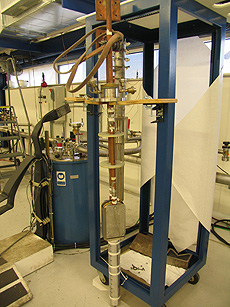Smaller, more powerful test stand for superconducting cables at Fermilab
 |
The Superconducting Strand and Cable R&D Group recently built a new superconducting cable test stand, located in Industrial Building 3a. Its transformer, made of coiled superconducting wire, is attached to the stand about two feet from the ground. Photo: Sarah Khan
|
Testing key magnet components has become ever more important to Fermilab's High-Field Magnet Program, especially since the recent development of an 11-Tesla superconducting magnet.
To test the cables for such magnets, the Technical Division's Superconducting Strand and Cable R&D Group recently built a test stand able to deliver almost 15-Tesla fields, trouncing the capacity of similar facilities at a fraction of the size and cost. Such high fields means the group can now test magnet cables for the stringent standards of the LHC luminosity upgrades and other projects.
"This facility has a lot of potential, and we're looking forward to using it in future experiments," said Alexander Zlobin, head of the High-Field Magnet Program.
A similar facility currently in use at CERN can deliver a 10-Tesla field, but requires high-current supplies to power the magnet and test cable as well as large, strong mechanical structures to keep from deforming the sample in the magnetic field, said Superconducting Strand and Cable R&D Group Leader Emanuela Barzi.
That and other factors mean it can cost an experiment around $20,000 to prepare and test a single cable at that facility.
Fermilab's cable test stand, however, is built with a compact but powerful solenoid eight inches in diameter and 10 inches tall—small enough to fit on a bookshelf.
"We realized that, with the space constraints we had, we needed to get creative with our design," Barzi said.
The test cable sits inside the solenoid's center hole and connects to a transformer that delivers currents up to 25,000 amps from an input of just 600 amps. The group configured the cable in a way that results in much lower destructive forces than measured at other facilities, and thus less chance of structural damage to small, lightweight components.
All this is done inside a small liquid-helium tank at very cold temperatures, allowing the cables to superconduct.
The final cost is less than $2,500 per cable preparation and test, Barzi said. Some projects have already expressed interest in using the test stand, she added.
"The United States LHC Accelerator Research Program is interested in using this test stand to test cables for the LHC upgrades, and we are also looking into possibilities of using this for versions of muon colliders or Higgs factories," Zlobin said. "This facility would serve well for cable and magnet development for all these very interesting concepts in high-energy physics."
—Sarah Khan
|